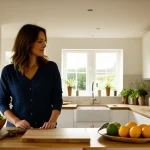Essential Components of a Perfect Roast Dinner
Crafting a perfect roast dinner hinges on mastering the roast dinner essentials, which include selecting quality ingredients and thoughtful preparation. The foundation begins with choosing the best cuts of meat—for example, beef rib, leg of lamb, or pork shoulder—each offering distinct textures and flavors that influence the whole meal. Complementing your meat, seasonal produce like root vegetables and fresh greens ensures balance and vibrancy on the plate.
Structuring your roast dinner involves layering flavors and textures for maximum satisfaction. This means coordinating your sides and main course so that everything harmonizes. For instance, pairing crisp roast potatoes with tender vegetables and rich gravy highlights the skill behind the key elements of roast dinners.
Also read : How Can UK Cooking Traditions Inspire Modern Sustainable Practices?
Importantly, success in home cooking demands adequate preparation and planning. From marinating meat the night before to preheating the oven just right, timing impacts both taste and texture. Taking these steps guarantees your efforts translate into a satisfying meal.
By focusing on these roast dinner essentials—from ingredient choice to preparation tactics—you set yourself up for home cooking success and a truly memorable dining experience.
This might interest you : What Are the Unique Historical Influences on British Cuisine?
Meat Selection, Preparation, and Cooking Techniques
Selecting the right meat is crucial for roast dinner success. Prime cuts such as rib roast, leg of lamb, or pork shoulder deliver distinct flavours and textures that shape the meal’s character. When considering meat selection for roasts, opt for well-marbled pieces to ensure juiciness and tenderness.
Seasoning techniques enhance the meat’s natural taste. Simple blends of salt, pepper, and herbs work well, while marinades can add complexity. Applying seasoning evenly and allowing time for absorption—ideally before roasting—maximises flavour penetration.
Accurate roasting temperatures significantly impact the outcome. Typically, a higher temperature at the start helps develop a crisp crust, followed by a lower temperature to cook the meat evenly. For example, roasting beef at 220°C briefly before reducing to 160°C ensures a juicy, tender interior.
Cooking times must align precisely with meat weight and desired doneness. Using a thermometer helps avoid undercooking or overcooking, common pitfalls in home cooking. Resting meat after roasting redistributes juices, preserving moisture.
Combining these perfect roast tips—thoughtful meat selection, seasoning, and temperature control—lays the foundation for a memorable roast dinner.
Achieving Crispy Roast Potatoes and Satisfying Sides
To master crispy roast potatoes, start by selecting floury potatoes like Maris Piper. Peel and cube them evenly, then parboil for 8-10 minutes until the edges soften. This step ensures the right texture inside. After draining, shake them gently in the pot to roughen their surfaces—this creates more edges to crisp up during roasting.
For seasoning, use hot fat such as goose fat or olive oil generously; it coats the potatoes and helps achieve a golden, crunchy crust. Roast at a high temperature (around 220°C) and turn occasionally to promote even browning. These perfect roast tips capitalize on texture contrast—crispy outside, fluffy inside—which is the hallmark of roast dinner essentials.
Complementing your potatoes, roast vegetables such as carrots, parsnips, and Brussels sprouts benefit from similar care. Toss them in olive oil, salt, and herbs before roasting to deepen flavors without overwhelming the dish. Balancing your sides enhances the overall meal harmony, highlighting the key elements of a classic roast.
Achieving this balance and texture elevates your home cooking success, making your roast dinner both gratifying and memorable.
Mastering Gravy and Flavor Enhancements
Creating homemade gravy from pan drippings is a cornerstone of roast dinner essentials. After roasting, the browned bits left in the tin hold concentrated flavours. To capture this, deglaze the pan with stock or wine, scraping to dissolve caramelised residue. This forms a flavourful base for your gravy.
For a silky texture and depth, thicken the liquid with a roux—equal parts butter and flour cooked briefly before adding the deglazing liquid. Stir continuously to avoid lumps. This technique unlocks rich, velvety consistency, a key element that elevates any roast.
Adding flavor enhancers such as fresh herbs (thyme, rosemary), black pepper, or a splash of soy sauce introduces complexity and umami. Experimenting with mustard or a touch of balsamic vinegar can provide balance and brightness.
Complementary sauces and condiments further diversify your roast dinner essentials. Mustards, chutneys, or horseradish offer sharp or sweet contrast that enlivens the plate. Thoughtful finishing touches like these showcase your attention to detail and contribute significantly to home cooking success.
Mastering these perfect roast tips transforms a simple gravy into a highlight, uniting all elements of your roast dinner with rich, unforgettable flavour.
Timing, Coordination, and Serving Strategies
Optimal roast dinner timing is vital for home cooking success. Precise scheduling ensures all components finish simultaneously, retaining freshness and flavour. Start by calculating cooking times based on meat weight and side preparation. For example, if roasting beef requires 90 minutes, prep potatoes and vegetables to go in the oven midway, allowing them to cook fully just as the meat rests.
Efficiently managing oven space helps achieve this balance. Use lower racks for slow-cooking meats and top racks for quicker sides. This prevents overcrowding and uneven heat distribution—key elements for perfect roasting. Consider resting meat under foil for 15-20 minutes after cooking; this distributes juices evenly, improving tenderness and flavour while you finish sides.
Serving methods also impact presentation and enjoyment. Carve meat just before serving to maintain warmth and moisture. Arrange each plate with a balance of meat, crispy potatoes, roasted vegetables, and a drizzle of fresh gravy. This thoughtful coordination enhances the dining experience, highlighting the roast dinner essentials.
Mastering these perfect roast tips—from timing and oven use to serving—transforms a simple roast into an impressive, well-executed meal that guests will appreciate.
Common Pitfalls to Avoid and Expert Tips
Avoiding typical roast dinner mistakes is essential for home cooking success. One frequent error is overcooking meat, leading to dryness. Use a reliable thermometer and follow precise cooking times. Undercooking, especially with large joints, risks unsafe consumption and unpleasant textures.
Another common pitfall is under-seasoning. Inadequate salt or herbs dull flavour, which undermines the meal’s impact. Applying seasoning evenly and allowing time for absorption ensure the seasoning blends well.
Achieving even roasting demands attention—overcrowding the oven blocks heat circulation, resulting in uneven cooking and inconsistent textures. Arrange items with space around them for crispier potatoes and uniformly roasted vegetables.
Experts advise resting meat for at least 15 minutes post-roast to redistribute juices and improve tenderness. It’s a key element often overlooked by home cooks.
Additional perfect roast tips include preheating your oven fully and using fats like goose fat for better crisping. Avoid opening the oven door frequently, as temperature fluctuations extend cooking time and affect results.
By recognizing these pitfalls and applying expert advice, you elevate your roast from ordinary to exceptional, securing both flavour and texture for a truly satisfying meal.



